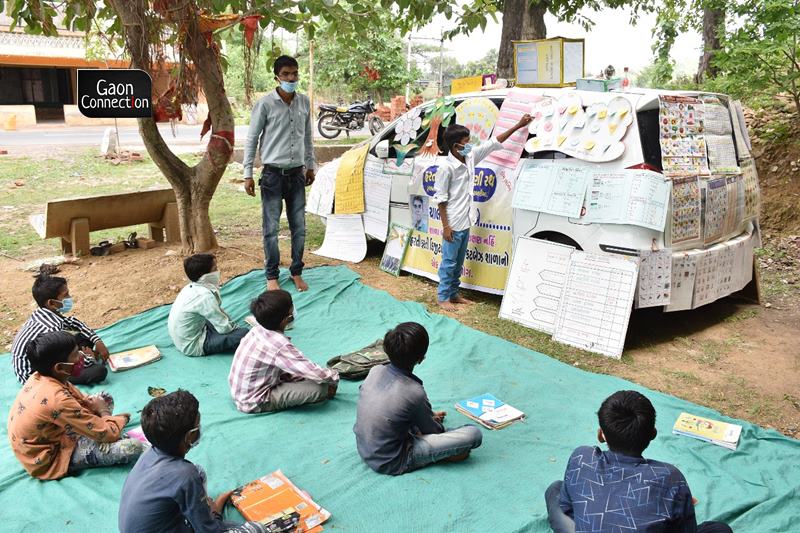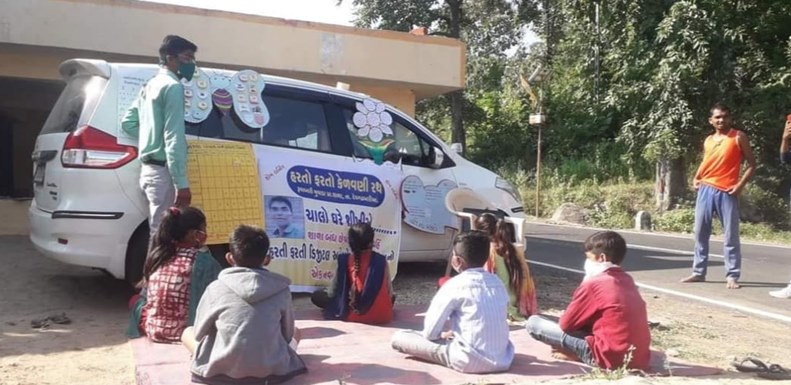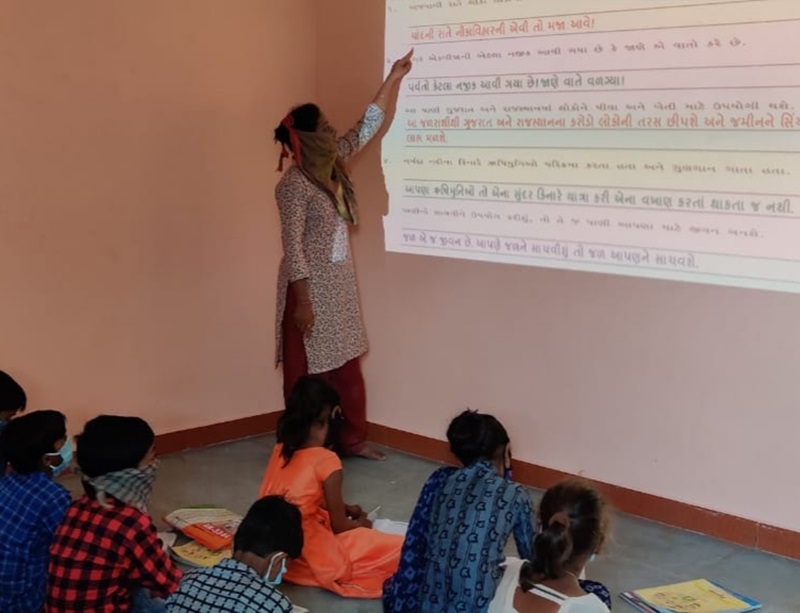Riding his ‘chariot of education’, a government school teacher is taking education places, literally
To counter the shutting down of schools during the COVID19 pandemic, Sanjay Chauhan, a primary teacher from Dahod district, Gujarat, has converted his car into a 'shiksha rath'. He loads it with teaching aids, and drives off every morning to Ruvabari village to impart learning to his students.


This government school teacher is on a mission to educate rural children during the pandemic. All photos: By arrangement
Dahod, Gujarat
Sanjay Chauhan is taking education places. Literally. He gets into his white Maruti Suzuki Ertiga car, at day break, sometimes even before sunrise and drives off. His destination? Ruvabari Muvada village in, Babriya tehsil, Dahod district, Gujarat, about 200 kms from Gandhinagar the state capital.
Chauhan lives at Pipodra village, in Dhanpur tehsil, and drives 12-15 kilometres everyday to Ruvabari where 350 children await him eagerly with their books and pencils.
The 31-year-old government school teacher is on a mission to educate rural children and ensure their schooling is uninterrupted during the COVID19 pandemic. Chauhan has been a teacher for seven years at the Ruvabari Muvada Primary School. He bought his car in 2018, he said, never dreaming that he would be putting it to such rigorous use by converting it into a shiksha rath (chariot of education).
Chauhan uses his shiksha rath as a mobile ‘whiteboard’ with colourful chart papers, lessons in Gujarati language, and kids’ project works pasted all over it. The excitement of students on spotting the shiksha rath every morning is palpable, said the school teacher.
“I teach students of classes one to eight. I began by simplifying tough concepts in each subject,” Chauhan told Gaon Connection. He has created study material and teaching aids to keep the children interested.

COVID19 and closure of schools
Economy and education in the country have been the most adversely affected by the COVID19 pandemic. And, like schools across the country, the Ruvabari Primary School where Chauhan has taught for seven years, shut down too.
Earlier this year, a report by UNICEF pointed out how merely 8.5 per cent students in India have access to the internet — a technological handicap that is at the cost of the children’s right to education amidst the COVID19 pandemic and the resulting closure of schools. The UNICEF report — ‘COVID-19 and School Closures: One year of education disruption’ — indicated that under the given circumstances, the school drop-out rate which is already high in India, may escalate further.
More than six million boys and girls in India were unable to access school education even before the outbreak of COVID19 and the pandemic is feared to have only pushed this number higher.
But, instead of being defeated by the pandemic and the closure of his school, Chauhan, the government teacher, decided to take the school to young students, wherever they were. In the pandemic, committed teachers such as Chauhan, are making a huge difference. They are the ones that keep the teaching and learning going, where otherwise, education would have come to a grinding halt.

Learning on the move
Chauhan refers to his white car, loaded with teaching aids, as the shiksha rath, or the chariot of education. He ferries books, projects, experiment models, charts, etc., to wherever his students are. Since April 1, 2020, Chauhan has continued to educate children and keep them motivated and driven.
“We never felt that our school had closed down,” Patel Ravishankar, a class seven student from Ruvabari, told Gaon Connection. His classmate Raju Patel, chipped in with, “I have been coming here to study for a year now and am studying in class seven.” Naina Janak said she loved studying and eagerly awaited the arrival of the shiksha rath, so that she could continue learning.
A bumpy start
It was not easy initially, admitted Chauhan. It was debatable if parents would allow their children to come out in the pandemic. “Fortunately COVID19 cases in the first wave were negligible in villages,” he said. Even then, only about 150 children turned up initially for the classes. Some were from his own school and others came from nearby private schools.
Also Read: The Village School: Where local should be vocal

“I divided the children into three groups and called them to class on different days, so there would be no crowding,” Chauhan explained. Good intentions always find a way out of difficulties and soon, Chauhan said, parents relented and sent their children to study.
“Other teacher colleagues soon joined me and presently five of us teach nearly three hundred and fifty students,” Chauhan said. “I drive my shiksha rath to this village and I pay for the petrol myself,” he added.
The classes are usually held outdoors, near his car that is covered in charts. And, when there is a need for use of projectors and laptops, he uses the village community centre.
Also Read: The village schoolmaster: Why Chhattisgarh’s Ashok Lodhi is called Cinema Babu by a village

Chauhan’s initiative to keep the continuity of studies even during the difficult days of the pandemic has enthused other teachers to do the same. Many of them, he said, were teaching children from 7 am to 12 noon at their villages.
There are several motivated and progressive minded teachers such as Chauhan who are, as per the state government’s directives, going to the villages where their students live and teaching them. They go armed with their laptops, and projectors, that the state government has provided them, to keep the thread of education uninterrupted and enthuse children as they learn new things.
Also Read: Reaching out to the last child in the learning curve in the pandemic

